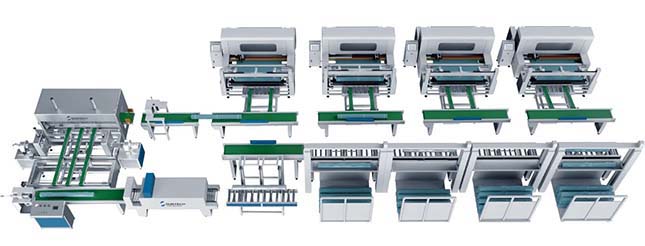During the epidemic, driven by the demand for epidemic prevention materials, the export scale of the textile industry reached a new high since 2015. According to customs statistics, the total export value of Chinese textile and apparel products in 2020 was $291.22 billion, a year-on-year increase of 9.6%, with a growth rate 11.1 percentage points higher than the previous year. Among them, the export value of textiles was $153.84 billion, a significant increase of 29.2% compared to the previous year, accounting for a much higher proportion of the total industry export value, rising from 44.3% to 58.2%. However, in the complex domestic and international situation and considering the high base of the previous year, China's clothing exports achieved some growth in 2022, but the growth rate significantly slowed down. According to China Customs statistics, from January to December, China's cumulative clothing exports amounted to $175.4 billion, a year-on-year increase of 3.2%, with a growth rate 1.4 percentage points slower than the previous 11 months. In November and December, clothing exports were $13.12 billion and $14.29 billion respectively, a year-on-year decrease of 14.5% and 10.1%. Compared with the 16.8% decline in October, the downward trend has slightly slowed down.

Textile and apparel are the end links of the demand chain and the closest display section of textile products to consumers. Therefore, they greatly influence the domestic and foreign export development of the textile industry. Hence, the relevant process of textile fabric roll finishing is particularly important.
The weaving process mainly includes warping, beaming, sizing, drawing-in, weaving, and finishing. Among them, the most time-consuming and least efficient stage is finishing, as it involves labor-intensive and time-consuming fabric inspection and the less automated process of finishing and packaging large fabric rolls. Therefore, the key to improving textile production efficiency lies in fabric inspection and packaging. An intelligent fabric inspection and packaging line can significantly improve the production efficiency of these 2 stages.
Vital Role of the Fabric Roll Inspection
During the weaving and dyeing and finishing processes, fabrics inevitably produce various defects (weaving defects, dyeing and finishing defects, printing defects, etc.). Fabrics with these defects should be eliminated; otherwise, the garments made from them will be defective. This is especially true for mass-produced garments that require multiple layers of fabric cutting. If fabrics with defects are mixed in, it will result in a large number of defective garments. Therefore, the fabric must be inspected before cutting, and noticeable marks should be made on the areas with defects so that they can be removed or cut out after the garment pieces are cut.
Fabric inspection can be done on dedicated fabric inspection machines or manually while laying the fabric. In addition to inspecting fabric defects, fabric inspection also includes checking the fabric's width, color differences, skewness, and verifying the fabric's length.
4-Point Inspection System
The "4-Point Inspection System" is the most common method used in on-site fabric inspection for textile goods. The system allows a maximum of four points to be assigned within a one-meter span, regardless of the size or quantity of defects.
1. The fabric is visually inspected by moving in the warp direction, ensuring a visible range of one meter for inspection.
2. Defects are assessed based on the fabric's intended use, with a visual distance of 70cm to 90cm from the fabric surface.
3. Localized defects and linear defects are measured based on their length, while patch defects are measured based on their maximum length or width. The scoring is done according to reference table 1.
4. Regardless of the size or quantity of defects, a maximum of four points is assigned within a one-meter span.
5. Damaging defects, regardless of their size, are assigned four points per linear meter.
6. Clearly scattered defects are assigned four points per meter.
7. For effective width, any deviation exceeding 2.0% is assigned four points per meter.
8. Skewness of the grain line is measured vertically within a limit of one and horizontally within the fabric's width. Any deviation exceeding 5.0% is assigned four points per meter. If post-washing distortion measurement is required, the skewness issue can be resolved through negotiation between the buyer and the supplier.
9. Evaluation of color difference compared to the standard: Below level 4, four points per meter.
10. Evaluation of color difference within the same roll: Below levels 4-5, four points per meter for the entire roll.
11. Evaluation of color difference within the same lot: Below level 4, four points per meter for both comparison samples.
12. Each seam is assigned four points.
13. Defects within the first 30cm from the fabric edge are not scored.
14. Fabric length is measured using a length measuring device.
The 4-Point Inspection System is a commonly used method for quality inspection of fabrics at present.
Crucial Importance of the Fabric Roll Packing
The textile industry itself produces fabrics, and these fabrics are used to make beautiful clothes. Clothes, in turn, serve the purposes of keeping warm, conveying visual aesthetics, and packaging the wearer. Therefore, ultimately, textiles aim to achieve the functions of packaging and presenting beauty. Textiles serve the packaging industry, which means that textiles themselves require packaging. Automatic Packaging Machines enable the orderly packaging of textile fabrics, ensuring that the fabrics can proceed to the next process without hindrance due to disorganization and difficulty in handling. Furthermore, after critical stages like fabric inspection and packaging in some factories, fabric rolls need to be transported to the next location for garment production. Packaging the fabric rolls facilitates efficient transportation and reduces the chances of damage during transit.
The Automatic Packaging Machine from SUNTECH Textile Machinery maximizes productivity with its high capacity and intelligent features. It enables one operator to oversee the entire packing process, thanks to its smart classification system.




